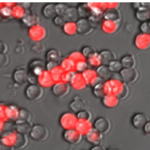Yanni Lin, TJ Cradick, Gang Bao and colleagues from Georgia Tech and Emory reported recently in Nucleic Acids Research on how the CRISPR/Cas9 gene editing system can sometimes miss its mark.
CRISPR/Cas9 has received abundant coverage from science-focused media outlets. Basically, it is a convenient system for cutting DNA in cells in a precise way. This paper shows that the CRISPR/Cas9 system can sometimes cut DNA in places that don’t exactly match the designed target.
Here we show that CRISPR/Cas9 systems can have off-target cleavage when DNA sequences have an extra base or a missing base at various locations compared with the corresponding RNA guide strand…Our results suggest the need to perform comprehensive off-target analysis by considering cleavage due to DNA and sgRNA bulges in addition to base mismatches.
CRISPR/Cas9 could be used to develop therapies for humans for genetic blood diseases such as sickle cell or thalassemia, and this paper does not change that potential. But the authors are cautioning fellow scientists that they need to design their tools carefully and perform quality control. Other investigators have made similar findings.





